Scotland's People Annual report: Results from 2009 Scottish Household Survey
A National Statistics publication for Scotland, providing reliable and up-to-date information on the composition, characteristics, behaviour and attitudes of Scottish households and adults.
13 Culture and Sport
Introduction and Context
The Scottish Government promotes sport and culture because of the benefits brought by each to communities and individuals. The Government aims both to widen access and participation, and to increase excellence, contributing towards the Government's strategic objectives 73 including: Expand opportunities for people in Scotland to succeed from nurture through to life long learning, ensuring higher and more widely shared achievements; Help people to sustain and improve their health, especially in disadvantaged communities, ensuring better, local and faster access to health care; Help local communities to flourish, becoming stronger, safer places to live, offering improved opportunities and a better quality of life.
The culture and sport suite of questions within the SHS covers attending cultural events and places, and participating in cultural and sports activities. As well as establishing attendance and participation, the frequency of undertaking these activities was also investigated. This chapter explores the prevalence and frequency of undertaking cultural activities and attending cultural events and places of culture in the last 12 months and of participation in sport in the last 4 weeks. Differences are investigated in participation at all, and in specific types of activity, among the total population of adults and particular sub-groups of interest.
Throughout the analysis, reference to "any activity" means that people do at least one activity from the available list (rather than each and every activity).
Participation in Cultural activities
Respondents are asked to say in which cultural activities (excluding as a result of paid work, school or academic activities) they have participated during the last 12 months. Figure 13.1 presents the results for adults as a whole.
Almost three-quarters (74%) have participated in cultural activities in the last 12 months. The predominant activity is reading for pleasure (excluding newspapers, magazines or comics), with almost two-thirds of adults (63%) having done so. Dance is the next most popular with just under one fifth of adults (19%) having taken part in this. This is followed by crafts such as textile, wood, pottery, etc (11%); playing a musical instrument or writing music (11%); and art or sculpture (10%). Participation rates for each of the other activities are less than 10%. All these figures are broadly comparable to those from 2007/2008.
Figure 13.1: Participation in cultural activities in the last 12 months
2009 data, Adults (base: 9,135)
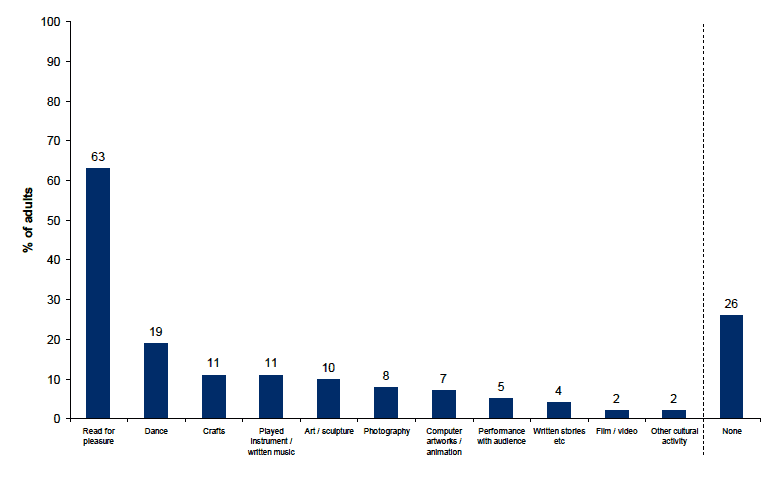
Table 13.1 shows women are more likely than men to have taken part in any of the cultural activities in the past 12 months, 79% and 68% respectively. Participation in any of the cultural activities is similar, around three quarters, for all ages until the age of 75 when it drops to just over two thirds (67%).
Table 13.1: Participation in any cultural activity in the last 12 months by age and gender
Column percentages, 2009 data
Adults |
Male |
Female |
16 to 24 |
25 to 34 |
35 to 44 |
45 to 59 |
60 to 74 |
75 plus |
All |
|---|---|---|---|---|---|---|---|---|---|
Not participated in any |
32 |
21 |
27 |
24 |
26 |
27 |
25 |
33 |
26 |
Participated in any |
68 |
79 |
73 |
76 |
74 |
73 |
75 |
67 |
74 |
Total |
100 |
100 |
100 |
100 |
100 |
100 |
100 |
100 |
100 |
Base |
4,027 |
5,108 |
750 |
1,214 |
1,597 |
2,220 |
2,178 |
1,176 |
9,135 |
The higher the level of qualification 74 attained the more likely an individual is to have participated in any of the cultural activities in the past 12 months; for example, 57% of those with no qualifications compares against 89% of those with a degree or professional qualification for those who have participated in any cultural activity in the last 12 months (Figure 13.2). Around two thirds of adults with O Grade, Standard Grade or equivalent have participated in any cultural activity in the previous 12 months.
Figure 13.2: Participation in any cultural activity in the last 12 months by highest level of qualification
2009 data, Adults (base: 9,135)
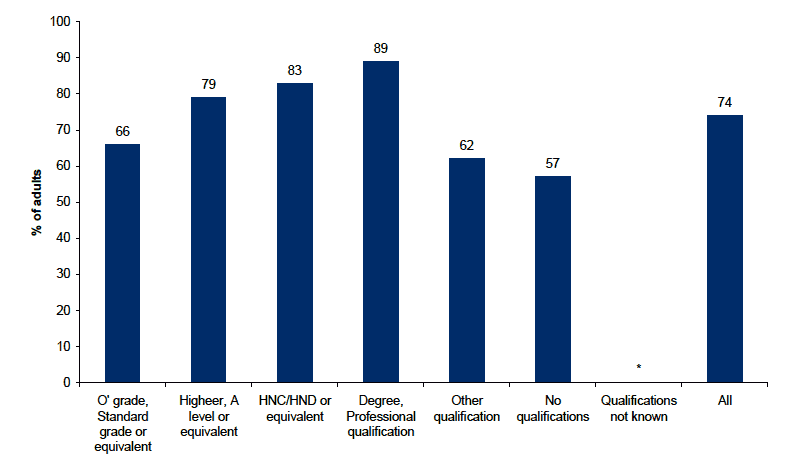
Figure 13.3: Participation in any cultural activity in the last 12 months by Scottish Index of Multiple Deprivation
2009 data, Adults (base: 9,124)
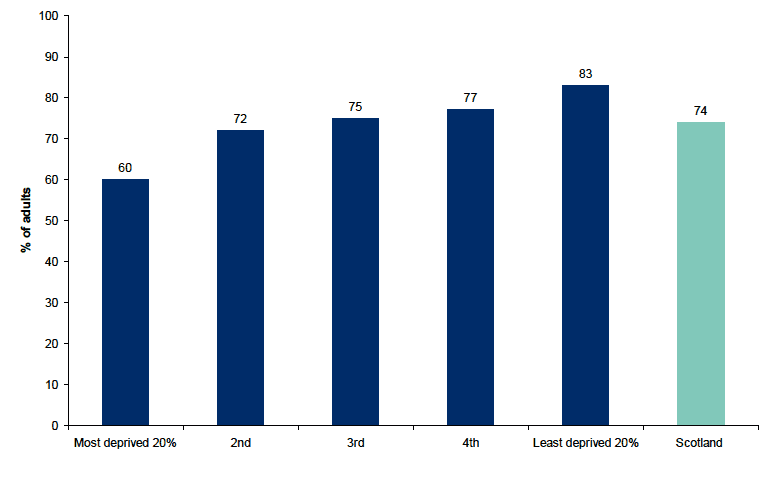
Figure 13.3 shows that participation in cultural activities in the past 12 months increases as area deprivation reduces. 75 In the most deprived areas participation in any cultural activity is below the Scotland average at around three fifths of adults (60%); this steadily increases to reach 83% in the least deprived areas.
There are also differences in participation in cultural activities when considering those that have any long-standing illness, health problem or disability. Figure 13.4 shows that those with a disability, illness or health problem (69% or less) are less likely to participate than those without (76%). Those with an illness or health problem only (69%) are more likely to participate in a cultural activity than those with a disability (63%) or both (61%).
Figure 13.4: Participation in any cultural activity in the last 12 months by long-standing illness, health problem or disability
2009 data, Adults (base: 9,135)
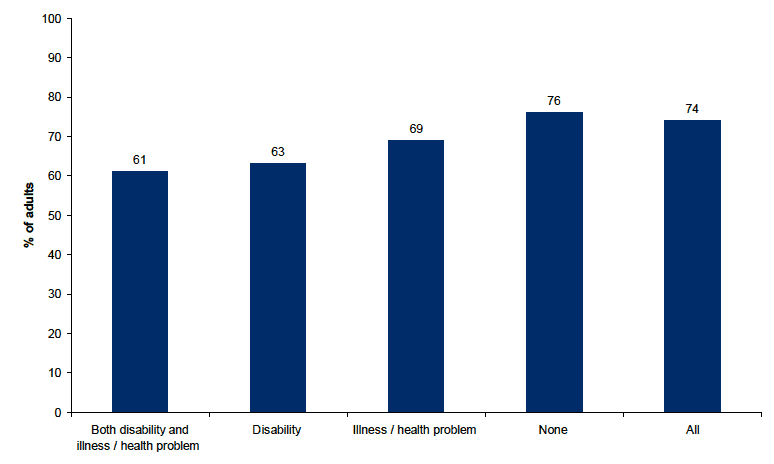
Types of activities
In Figure 13.2 participation in any cultural activity was shown to vary by highest level of qualification. Examination of participation in individual cultural activities shows that this relationship is driven by the predominance of reading for pleasure. Eighty two per cent of adults with a degree or professional qualification read for pleasure (Table 13.2).
For most other activities, those with Highers or equivalent qualifications, with HNC/ HND or equivalent and with a degree or professional qualification have broadly similar levels of participation. Participation remains lower for activities among those with 'O' Grades or equivalent than those with the various higher level qualifications.
Table 13.2: Participation in cultural activities in the last 12 months by highest level of qualification
Percentages, 2009 data
Adults |
'O' Grade, Standard grade or equiv |
Higher, A level or equivalent |
HNC/ HND or equivalent |
Degree, Professional qualification |
Other qualification |
No qualifications |
Qualifications not known |
All |
|---|---|---|---|---|---|---|---|---|
Read for pleasure |
53 |
67 |
71 |
82 |
52 |
47 |
* |
63 |
Dance |
18 |
23 |
24 |
25 |
12 |
11 |
* |
19 |
Crafts such as textile, wood, pottery, etc. |
8 |
12 |
14 |
16 |
11 |
8 |
* |
11 |
Played musical instrument / written music |
10 |
14 |
10 |
13 |
4 |
4 |
* |
10 |
Painting / drawing / printmaking / sculpture |
8 |
17 |
13 |
18 |
2 |
3 |
* |
11 |
Photography |
5 |
10 |
12 |
13 |
3 |
2 |
* |
8 |
Computer artworks or animation |
6 |
9 |
11 |
11 |
1 |
2 |
* |
7 |
Rehearsed/performed/sang |
3 |
8 |
5 |
9 |
1 |
1 |
* |
5 |
Written stories / books / plays / poetry |
3 |
5 |
4 |
7 |
2 |
2 |
* |
4 |
Made films/videos |
1 |
2 |
2 |
3 |
1 |
0 |
* |
2 |
Other cultural activity |
2 |
3 |
3 |
4 |
1 |
1 |
* |
2 |
None |
34 |
21 |
17 |
11 |
38 |
43 |
* |
26 |
Columns add to more than 100% since multiple responses allowed.
This question is only asked of three quarters of the sample.
There are different participation rates for a number of individual activities by gender (Table 13.3). A higher proportion of women than men have read for pleasure (69% compared to 57%) or taken part in dance (22% and 15%). In contrast, men are more likely than women to have taken part in photography as an artistic activity (14% compared to 8%). The proportions of men and women undertaking the remaining activities are similar.
Table 13.1 demonstrated that participation in any cultural activity was similar up to the age of 74 and then declined. However, looking at specific activities (Table 13.3) many show a decline in participation with increasing age. This is because the average number of activities in which adults take part declines as age increases. Participation in activities such as dancing shows higher proportions in the younger age groups (28% of those aged 16 to 24), decreasing with age through to those aged 75 plus (6%). This may in part be due to the interpretation of what 'dance' means, as it may encompass such activities as dancing in nightclubs through to ballroom dancing or others. There is a slight increase in participation in craft activities (such as textile, wood, pottery, etc) with age, with around 14% of those aged 60 and above participating in such activities.
Table 13.3: Participation in cultural activities in the last 12 months by gender and age
Percentages, 2009 data
Adults |
Male |
Female |
16 to 24 |
25 to 34 |
35 to 44 |
45 to 59 |
60 to 74 |
75 plus |
All |
|---|---|---|---|---|---|---|---|---|---|
Read for pleasure |
57 |
69 |
53 |
66 |
65 |
65 |
66 |
59 |
63 |
Dance |
15 |
22 |
28 |
24 |
17 |
18 |
17 |
6 |
19 |
Crafts such as textile, wood, pottery, etc. |
6 |
16 |
8 |
10 |
12 |
11 |
14 |
13 |
11 |
Played a musical instrument or written music |
8 |
11 |
18 |
13 |
10 |
7 |
6 |
5 |
10 |
Painting, drawing, printmaking or sculpture |
14 |
8 |
20 |
16 |
11 |
9 |
6 |
4 |
11 |
Photography as an artistic activity (not family or holiday 'snaps') |
9 |
6 |
10 |
8 |
7 |
8 |
7 |
3 |
8 |
Used a computer to create original artworks or animation |
9 |
6 |
11 |
12 |
8 |
6 |
4 |
1 |
7 |
Rehearsed, performed or sang in front of audience, e.g. play or choir (not karaoke) |
6 |
5 |
10 |
6 |
5 |
5 |
3 |
2 |
5 |
Written any stories, books, plays or poetry |
4 |
4 |
6 |
5 |
5 |
3 |
3 |
2 |
4 |
Made films or videos as an artistic activity (not family or holidays) |
2 |
1 |
5 |
2 |
2 |
1 |
1 |
0 |
2 |
Other cultural activity |
3 |
2 |
3 |
4 |
2 |
2 |
2 |
2 |
2 |
None |
32 |
21 |
27 |
24 |
26 |
27 |
25 |
33 |
26 |
Base |
4,027 |
5,108 |
750 |
1,214 |
1,597 |
2,220 |
2,178 |
1,176 |
9,135 |
Columns add to more than 100% since multiple responses allowed.
This question is only asked of three quarters of the sample.
Frequency of participation in cultural activities
For each cultural activity, those who participated were asked how frequently they did so in the last year. The results are shown in Table 13.4, presented in order of the percentage of people who participated. As well as being the most common activity overall, reading for pleasure is also undertaken more frequently than other cultural activities. Over eight-in-ten (83%) read for pleasure at least once a week. Painting, drawing, printmaking or sculpting is also relatively frequently undertaken by those who participate; over half (58%) of those who undertake this activity do so at least once a week. Making films or video is the activity that adults were the least likely to participate in, and is also undertaken most infrequently.
To aid comparison between different activities, a 'mean' was calculated by assigning approximate scores to the frequency scale used in this question. The resulting scores are shown in the right hand column of the table. These are intended to give a guide to relative frequency rather than a 'true' indication of average frequency with which each of the activities are undertaken. People who have read for pleasure have done so on average 45 times a year, which compares to around 20 times for other activities.
Table 13.4: Frequency of participating in cultural activities in the last 12 months
Row percentages, 2009 data
Adults |
At least once a week (52) |
Less often than once a week but at least once a month (12) |
Less often than once a month but at least 3-4 times a year (4) |
Twice in the last 12 months (2) |
Once in the last 12 months (1) |
Don't know |
Total |
Base |
'Mean' |
|---|---|---|---|---|---|---|---|---|---|
Read for pleasure |
83 |
10 |
5 |
2 |
1 |
0 |
100 |
5,847 |
44.6 |
Dance |
28 |
23 |
27 |
14 |
7 |
0 |
100 |
1,662 |
18.7 |
Crafts such as textile, wood, pottery, etc. |
45 |
23 |
19 |
8 |
4 |
0 |
100 |
1,140 |
27.1 |
Played a musical instrument or written music |
42 |
26 |
19 |
9 |
3 |
0 |
100 |
803 |
25.9 |
Painting, drawing, printmaking or sculpture |
58 |
22 |
12 |
5 |
2 |
0 |
100 |
881 |
33.4 |
Photography as an artistic activity (not family or holiday 'snaps') |
32 |
34 |
23 |
8 |
3 |
1 |
100 |
663 |
21.8 |
Used a computer to create original artworks or animation |
33 |
26 |
23 |
10 |
8 |
1 |
100 |
552 |
21.4 |
Rehearsed, performed or sang in front of audience, e.g. play or choir (not karaoke) |
33 |
22 |
20 |
11 |
13 |
1 |
100 |
403 |
20.9 |
Written any stories, books, plays or poetry |
36 |
27 |
19 |
7 |
10 |
1 |
100 |
354 |
22.9 |
Made films or videos as an artistic activity (not family or holidays) |
22 |
22 |
25 |
17 |
14 |
- |
100 |
139 |
15.5 |
Other cultural activity |
52 |
24 |
14 |
7 |
2 |
2 |
100 |
272 |
30.6 |
This question is asked of three quarters of the sample.
To enable mean frequency to be calculated values were assigned to the frequency scales as shown in the table in the headings row. These are approximate values only to aid interpretation of the data.
Attendance at cultural events and places
The next question in this series concerns attendance at cultural events and visiting places of culture (not as a result of paid work, school or academic activities). Once again respondents were asked about the last 12 months. Figure 13.5 presents the results for adults as a whole.
Almost three quarters (74%) of adults have attended cultural events or visited cultural places in the last 12 months. On average, these people attended approximately three different types of event or place during this time. Viewing a film at a cinema or other venue is the most common; just over half (53%) have done this in the last 12 months. Between a quarter and a third have visited a library (29%); attended a theatrical performance (27%); a live music event (27%) or a museum (26%). As before, these show little difference from 2007/2008 estimates.
Figure 13.5: Attendance at cultural events and visiting places of culture in the last 12 months
2009 data, Adults (base: 9,134)
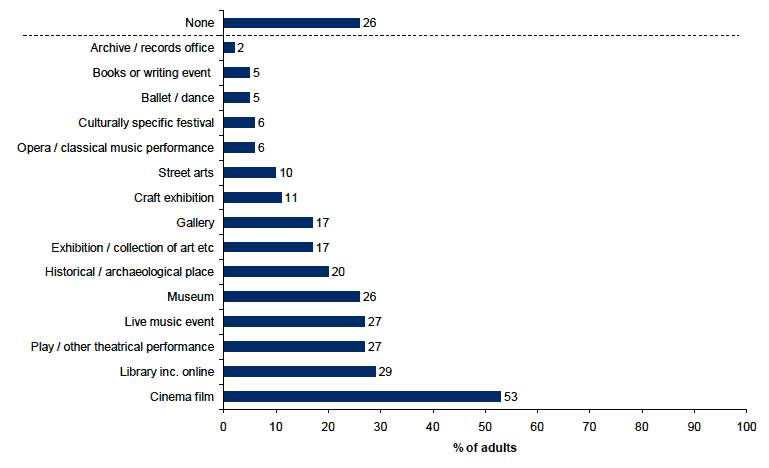
Table 13.5 shows that there is little difference by gender in overall attendance at cultural events and visiting places of culture; around three-quarters of both men and women have done so in the last 12 months. However, there is a difference according to age, with those aged 75 or older being least likely to attend a cultural event or visit a place of culture (46%) compared with over four-fifths of those aged 16-44 years old.
Table 13.5: Attendance at cultural events and visiting places of culture in the last 12 months by age and gender
Adults |
Male |
Female |
16 to 24 |
25 to 34 |
35 to 44 |
45 to 59 |
60 to 74 |
75 plus |
All |
|---|---|---|---|---|---|---|---|---|---|
No |
28 |
25 |
13 |
15 |
19 |
29 |
35 |
54 |
26 |
Yes |
72 |
75 |
87 |
85 |
81 |
71 |
65 |
46 |
74 |
Total |
100 |
100 |
100 |
100 |
100 |
100 |
100 |
100 |
100 |
Base |
4,027 |
5,107 |
750 |
1,213 |
1,597 |
2,220 |
2,178 |
1,176 |
9,134 |
As with participation in cultural activity, attendance at cultural events and visiting a place of culture increases as highest level of qualification increases (Figure 13.6); Attendance is lowest amongst those with no qualifications (47%) and much higher for those with a minimum level of O Grade (778%). A similar proportion of adults with Highers, 'A' level or equivalent and with HNC/ HND or equivalent have attended cultural events in the last 12 months, while over nine in ten (91%) of those with a degree or professional qualification have done so.
Figure 13.7 shows that attendance at cultural events in the last 12 months increases steadily as area deprivation decreases; in the 20% most deprived areas attendance is around two-thirds (62%) increasing to almost nine-in-ten (85%) in the 20% least deprived areas.
Figure 13.6: Attendance at cultural events and visiting places of culture in the last 12 months by highest level of qualification
2009 data, Adults (base: 9,134)
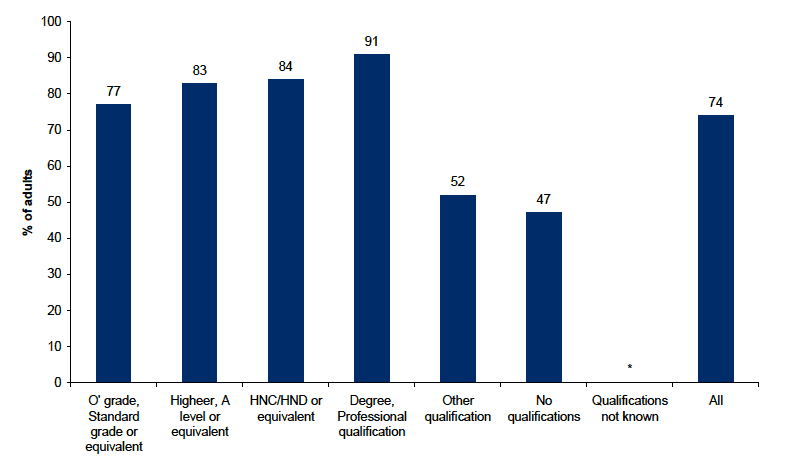
Figure 13.7: Attendance at cultural events and visiting places of culture in the last 12 months by Scottish Index of Multiple Deprivation
2009 data, Adults (base: 9,123)
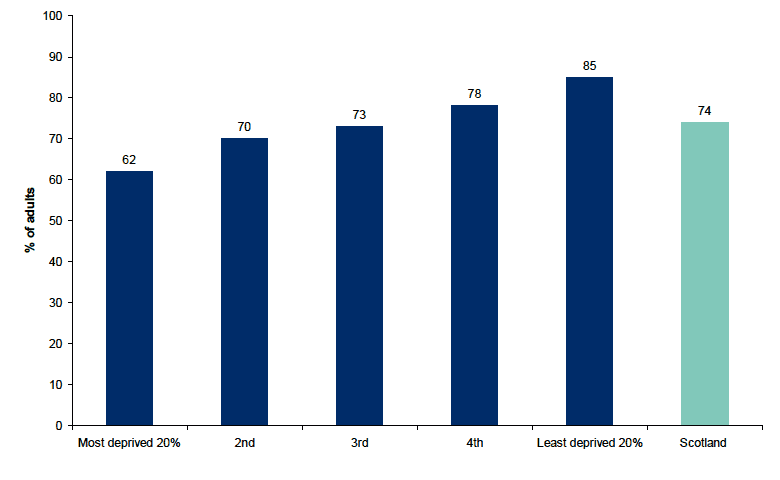
The final chart in this section (Figure 13.8) demonstrates that those with either a disability, illness or health problem, or both, are less likely to attend than those without.
Figure 13.8: Attendance at cultural events and visiting places of culture in the last 12 months by long-standing illness, health problem or disability
2009 data, Adults (base: 9,134)
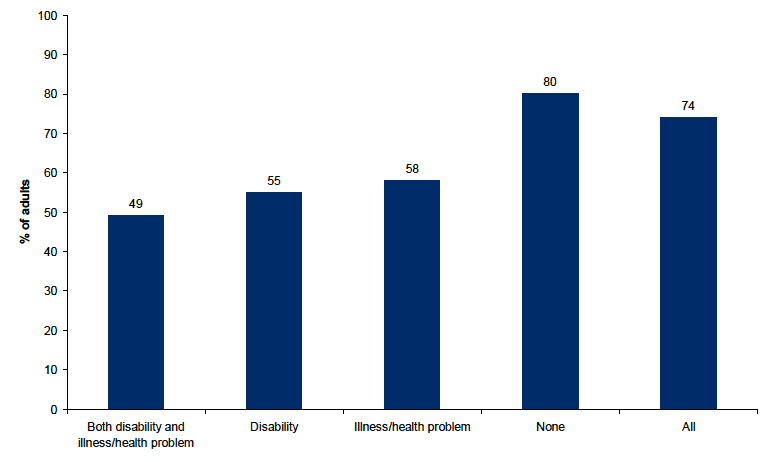
Types of activities
Table 13.6 shows some clear gender differences by specific types of event or place. A higher proportion of women than men have visited a library (32% females, compared to 25% males) or attended a play, drama or other theatrical performance (32% compared to 22%). In contrast, men are less likely to attend most cultural events more than women, though there is some evidence of them attending a place of historical or archaeological interest (22% males, compared to 18% females) or live music events such as jazz events (29% compared to 26%).
Cinema-going stands out from the majority of other activities in that attendance is greatest for younger adults and declines with age. For example 79% of 16-24 year olds have visited the cinema in the past 12 months compared with 13% of those aged 75 and over. Attending live music events similarly declines with age. Those aged 75 and over are the least likely of any age group to attend any of the cultural events or places.
Table 13.6: Attendance at cultural events and visiting places of culture in the last 12 months by gender and age
Percentages, 2009 data
Adults |
Male |
Female |
16 to 24 |
25 to 34 |
35 to 44 |
45 to 59 |
60 to 74 |
75 plus |
All |
|---|---|---|---|---|---|---|---|---|---|
Film at cinema or other venue |
51 |
54 |
79 |
73 |
64 |
49 |
30 |
13 |
52 |
Library (any type of library, e.g. public / mobile / online) |
25 |
32 |
29 |
32 |
32 |
26 |
28 |
23 |
28 |
Play, drama other theatrical performance (musical / pantomime) |
22 |
32 |
20 |
26 |
29 |
31 |
29 |
19 |
27 |
Other live music event e.g. jazz event |
29 |
26 |
36 |
39 |
32 |
28 |
16 |
7 |
27 |
Museum |
26 |
26 |
20 |
33 |
33 |
27 |
25 |
13 |
26 |
Place of historical or archaeological interest |
22 |
18 |
13 |
22 |
24 |
23 |
20 |
9 |
20 |
Exhibition or collection of art, photography or sculpture |
17 |
18 |
13 |
20 |
19 |
20 |
17 |
10 |
17 |
Gallery |
17 |
16 |
12 |
20 |
20 |
18 |
16 |
9 |
17 |
Craft exhibition |
8 |
13 |
5 |
9 |
11 |
15 |
13 |
7 |
11 |
Street arts (art in everyday surroundings like parks, streets or shopping centre) or circus (not animals) |
10 |
11 |
11 |
15 |
14 |
11 |
6 |
2 |
10 |
Opera / operetta / classical music performance |
5 |
7 |
3 |
4 |
5 |
7 |
9 |
7 |
6 |
Culturally specific festival (mela/feis) |
7 |
6 |
6 |
9 |
8 |
7 |
5 |
2 |
6 |
Ballet / contemporary dance / other live dance event e.g. multi cultural |
3 |
7 |
4 |
6 |
6 |
5 |
4 |
2 |
5 |
Event connected with books or writing |
5 |
5 |
4 |
5 |
6 |
6 |
5 |
2 |
5 |
Archive or records office |
3 |
2 |
2 |
2 |
3 |
3 |
3 |
1 |
2 |
None |
28 |
25 |
13 |
15 |
19 |
29 |
35 |
54 |
26 |
Base |
4,027 |
5,107 |
750 |
1,213 |
1,597 |
2,220 |
2,178 |
1,176 |
9,134 |
Columns add to more than 100% since multiple responses allowed.
This question is only asked of three quarters of the sample.
Table 13.7 reveals that, in some contrast to the findings on cultural participation, those having highest qualification at Degree or professional level show clearly the highest attendance for almost all events. Those with Highers or HNC/ HND form a group with a similar but intermediate level of attendance. Those with a degree show similar levels of attendance to these two groups for attending a film at a cinema or similar venue; approximately two-thirds of each of these groups has seen a film at a cinema or similar venue in the last 12 months.
Table 13.7: Attendance at cultural events and visiting places of culture in the last 12 months by highest qualification level
Percentages, 2009 data
Adults |
'O' Grade, Standard grade or equiv |
Higher, A level or equivalent |
HNC/ HND or equivalent |
Degree, Professional qualification |
Other qualification |
No qualifications |
Qualifications not known |
All |
|---|---|---|---|---|---|---|---|---|
Film at cinema or other venue |
59 |
66 |
65 |
69 |
23 |
22 |
* |
52 |
Library (any type of library, e.g. public / mobile / online) |
22 |
31 |
34 |
44 |
18 |
14 |
* |
28 |
Play, drama other theatrical performance (musical / pantomime) |
18 |
29 |
33 |
45 |
17 |
13 |
* |
27 |
Other live music event e.g. jazz event |
24 |
35 |
38 |
41 |
11 |
10 |
* |
27 |
Museum |
19 |
28 |
32 |
46 |
14 |
10 |
* |
26 |
Place of historical or archaeological interest |
12 |
20 |
23 |
39 |
9 |
5 |
* |
20 |
Exhibition or collection of art, photography or sculpture |
9 |
17 |
20 |
37 |
7 |
4 |
* |
17 |
Gallery |
7 |
18 |
19 |
34 |
6 |
5 |
* |
17 |
Craft exhibition |
7 |
11 |
12 |
20 |
6 |
4 |
* |
11 |
Street arts (art in everyday surroundings like parks, streets or shopping centre) or circus (not animals) |
8 |
12 |
13 |
19 |
3 |
3 |
* |
10 |
Opera / operetta / classical music performance |
2 |
5 |
6 |
14 |
5 |
2 |
* |
6 |
Culturally specific festival (mela/feis) |
4 |
6 |
9 |
13 |
1 |
1 |
* |
6 |
Ballet / contemporary dance / other live dance event e.g. multi cultural |
3 |
3 |
6 |
11 |
2 |
1 |
* |
5 |
Event connected with books or writing |
2 |
5 |
5 |
12 |
1 |
1 |
* |
5 |
Archive or records office |
1 |
3 |
4 |
5 |
0 |
0 |
* |
2 |
None |
23 |
17 |
16 |
9 |
48 |
53 |
* |
26 |
Base |
1,571 |
1,216 |
828 |
2,357 |
618 |
2,490 |
54 |
9,134 |
Columns add to more than 100% since multiple responses allowed.
This question is only asked of three quarters of the sample.
Considering how attendance varies by income, Table 13.8 reveals there is greater attendance as household income increases for nearly all events (other than those within the £0 to £6,000 income group, which usually starts out with higher attendance rates than those from the £6,001 to £10,000 income group).
Table 13.8: Attendance at cultural events and visiting places of culture in the last 12 months by total annual household income
Percentages, 2009 data
Adults |
£0 - £6,000 |
£6,001 -£10,000 |
£10,001 -£15,000 |
£15,001 - £20,000 |
£20,001 - £25,000 |
£25,001 - £30,000 |
£30,001 - £40,000 |
£40,001+ |
All |
|---|---|---|---|---|---|---|---|---|---|
Film at cinema or other venue |
42 |
33 |
37 |
45 |
51 |
60 |
67 |
74 |
53 |
Library (any type of library, e.g. public / mobile / online) |
30 |
23 |
25 |
27 |
27 |
29 |
30 |
34 |
28 |
Play, drama other theatrical performance (musical / pantomime) |
20 |
17 |
19 |
22 |
26 |
28 |
33 |
42 |
27 |
Other live music event e.g. jazz event |
19 |
14 |
18 |
22 |
26 |
29 |
38 |
43 |
28 |
Museum |
20 |
14 |
19 |
24 |
25 |
28 |
33 |
40 |
26 |
Place of historical or archaeological interest |
14 |
9 |
11 |
15 |
19 |
24 |
25 |
34 |
20 |
Exhibition or collection of art, photography or sculpture |
12 |
8 |
11 |
15 |
16 |
18 |
21 |
30 |
17 |
Gallery |
11 |
9 |
10 |
12 |
16 |
18 |
20 |
28 |
16 |
Craft exhibition |
10 |
8 |
8 |
9 |
9 |
12 |
12 |
16 |
11 |
Street arts (art in everyday surroundings like parks, streets or shopping centre) or circus (not animals) |
9 |
6 |
6 |
9 |
9 |
11 |
14 |
17 |
11 |
Opera / operetta / classical music performance |
8 |
4 |
4 |
6 |
6 |
5 |
7 |
10 |
6 |
Culturally specific festival (mela/feis) |
7 |
3 |
3 |
5 |
7 |
8 |
7 |
9 |
6 |
Ballet / contemporary dance / other live dance event e.g. multi cultural |
7 |
3 |
3 |
4 |
5 |
5 |
6 |
8 |
5 |
Event connected with books or writing |
4 |
3 |
3 |
3 |
5 |
5 |
6 |
9 |
5 |
Archive or records office |
3 |
2 |
2 |
2 |
2 |
2 |
3 |
3 |
2 |
None |
36 |
43 |
39 |
28 |
27 |
21 |
14 |
11 |
26 |
Base |
456 |
1,201 |
1,807 |
1,339 |
1,019 |
820 |
1,112 |
1,074 |
8,828 |
Columns add to more than 100% since multiple responses allowed.
This question is only asked of three quarters of the sample.
Frequency of attending cultural events or places
Table 13.9 shows the frequency at which those who have visited places of culture or attended cultural events in the last year have done so, shown in descending order of attendance (at any event or place). Strikingly, the frequency with which adults use libraries is higher than any other cultural activity. One-in-five (20%) of those who have used a library in the last year have done so at least once a week and a further 39% have done so less often than weekly but at least once a month. Similarly, those watching a film at a cinema or other such venue less often than once a week though at least once a month (24%) is higher than the other events or places (other than library).
Once again a 'mean' has been calculated (by assigning approximate scores to the frequency scale used in this question) to provide a relative frequency measure, further highlighting the difference between using a library and all other activities listed. The mean frequency for using a library is 16.1, approximately the equivalent to between once and twice a month. Cinema-going is the next most frequently undertaken (on average around 7 days a year), followed by visiting an archive or records office, although this is undertaken by the fewest adults. Those attending either a museum or a gallery are also slightly higher (both 4.3 days on average).
Table 13.9: Frequency of attending cultural events and visiting places of culture in the last 12 months
Row percentages, 2009 data
Adults |
At least once a week (52) |
Less often than once a week / at least once a month (12) |
Less often than once a month / at least 3-4 times a year (4) |
Twice in the last 12 months (2) |
Once in the last 12 months (1) |
Don't know |
Total |
Base |
'Mean' |
|---|---|---|---|---|---|---|---|---|---|
Film at cinema or other venue |
4 |
24 |
43 |
20 |
9 |
0 |
100 |
4,256 |
6.9 |
Library (any type of library, e.g. public / mobile / online) |
20 |
39 |
22 |
13 |
6 |
0 |
100 |
2,617 |
16.1 |
Play, drama other theatrical performance (musical / pantomime) |
1 |
4 |
31 |
34 |
29 |
0 |
100 |
2,450 |
3 |
Other live music event e.g. jazz event |
2 |
7 |
30 |
35 |
27 |
0 |
100 |
2,310 |
3.7 |
Museum |
2 |
10 |
33 |
32 |
24 |
0 |
100 |
2,258 |
4.3 |
Place of historical or archaeological interest |
2 |
8 |
32 |
33 |
24 |
0 |
100 |
1,701 |
4 |
Exhibition or collection of art, photography or sculpture |
2 |
8 |
28 |
33 |
28 |
0 |
100 |
1,549 |
3.8 |
Gallery |
2 |
8 |
28 |
32 |
28 |
0 |
100 |
1,422 |
4.3 |
Craft exhibition |
1 |
5 |
21 |
38 |
35 |
0 |
100 |
1,067 |
2.9 |
Street arts (art in everyday surroundings like parks, streets or shopping centre) or circus (not animals) |
3 |
5 |
17 |
30 |
45 |
1 |
100 |
856 |
3.6 |
Opera / operetta / classical music performance |
1 |
4 |
25 |
28 |
40 |
1 |
100 |
610 |
3.1 |
Culturally specific festival (mela/feis) |
1 |
4 |
14 |
30 |
50 |
0 |
100 |
596 |
2.6 |
Ballet / contemporary dance / other live dance event e.g. multi cultural |
2 |
4 |
15 |
22 |
56 |
1 |
100 |
442 |
2.8 |
Event connected with books or writing |
3 |
8 |
21 |
29 |
39 |
1 |
100 |
446 |
4 |
Archive or records office |
5 |
8 |
19 |
32 |
35 |
1 |
100 |
231 |
5.4 |
This question is only asked of three quarters of the sample.
To enable mean frequency to be calculated values were assigned to the frequency scales as shown in the table in the headings row. These are approximate values only to aid interpretation of the data.
Participation in Sport
The final questions in this section investigated levels of participation among adults in sport. A broad definition of sport is used and includes, for example, recreational walking (for more than 30 minutes). For this question, adults were asked about participation in the last four weeks. The results are shown in Figure 13.9.
The 72% of people who had participated in any sport in the last four weeks undertook on average a little over two activities each. By far the most prevalent activity was walking for 30 minutes (for recreational purposes). Over half (54%) had done this in the last four weeks compared with fewer than one-in-five undertaking any other individual activity. When walking was removed, half of adults had undertaken at least one of the remaining sports activities in the last four weeks. Excluding walking, adults participating in other sports did so in an average of a little over two activities in the past four weeks, broadly comparable to the average when walking is included.
Figure 13.9: Participation in sport in the last four weeks
2009 data, Adults (base: 9,134)
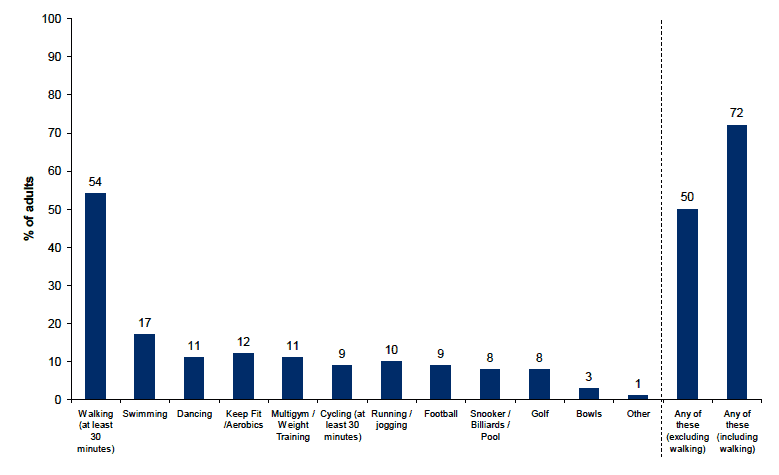
Previous analysis of SHS data 76 has shown that there is a relationship between participation in overall sport excluding and including walking and self-assessed health. Those who rated their own health over the last 12 months as good were more likely to participate in sport, though it is unclear from this to what extent good health is a result of taking part in sport or, instead, to what extent having good health enables participation in sport.
Table 13.10 shows that in 2009, those people who rated their health in general to be 'very good' or 'good' were more likely to participate in any sporting activity than those who had 'bad' or 'very bad' health. Including walking, 79% of those with 'good' or 'very good' health reporting participating in any sporting activity over the past twelve months compared to 31% who said they had 'bad' or 'very bad' health.
Table 13.10: Participation in any sporting activity and self-assessed health over past twelve months
Column percentages, 2009 data
Adults |
Very Good / Good health |
Fair health |
Very Bad / Bad health |
All |
|---|---|---|---|---|
Participation in any sporting activity excluding walking |
||||
No |
43 |
67 |
83 |
50 |
Yes |
57 |
33 |
17 |
50 |
Total |
100 |
100 |
100 |
100 |
Base |
6,469 |
1,957 |
694 |
9,120 |
Participation in any sporting activity including walking |
||||
No |
21 |
44 |
69 |
28 |
Yes |
79 |
56 |
31 |
72 |
Total |
100 |
100 |
100 |
100 |
Base |
6,480 |
1,958 |
699 |
9,137 |
It can also be seen that there is an increasing trend of participation in sports as deprivation decreases (Table 13.11). Those living in the 20% least deprived areas of Scotland are much more likely to participate in any sporting activity (80%, including walking) are compared to the 20% most deprived (62%).
Table 13.11: Participation in any activity by Scottish Index of Multiple Deprivation
Column percentages, 2009 data
Adults |
20% most deprived |
2 |
3 |
4 |
20% least deprived |
All |
|---|---|---|---|---|---|---|
Participation in any sporting activity excluding walking |
||||||
No |
57 |
56 |
52 |
46 |
40 |
50 |
Yes |
43 |
44 |
48 |
54 |
60 |
50 |
Total |
100 |
100 |
100 |
100 |
100 |
100 |
Base |
1,660 |
1,905 |
1,973 |
1,983 |
1,588 |
9,109 |
Participation in any sporting activity including walking |
||||||
No |
38 |
34 |
27 |
24 |
20 |
28 |
Yes |
62 |
66 |
73 |
76 |
80 |
72 |
Total |
100 |
100 |
100 |
100 |
100 |
100 |
Base |
1,666 |
1,909 |
1,979 |
1,984 |
1,588 |
9,126 |
Differences in sports participation levels between genders and between adults of different ages are explored in Table 13.12. The percentage of women who had participated in sport in the last four weeks was lower than the corresponding figure for men (69% versus 75%). Among different age groups, participation was highest among those aged 16 to 24 (84%), thereafter, participation decreased steadily until the age of 75, after which there was a sharp reduction with only 39% of those aged 75 and over engaging in sport in the past four weeks. The range of activities also reduced as age increased; those aged 16 to 24 had participated in between 2 and 3 different activities on average, compared with an average of between 1 and 2 for those aged 75 or over.
Table 13.12: Participation in sport in the last four weeks by gender and age
Percentages, 2009 data
Adults |
Male |
Female |
16 to 24 |
25 to 34 |
35 to 44 |
45 to 59 |
60 to 74 |
75 plus |
All |
|---|---|---|---|---|---|---|---|---|---|
Walking (at least 30 minutes for recreational purposes) |
52 |
55 |
51 |
60 |
61 |
56 |
53 |
29 |
54 |
Swimming |
16 |
19 |
23 |
25 |
27 |
15 |
9 |
2 |
18 |
Dancing |
8 |
14 |
18 |
14 |
10 |
10 |
9 |
3 |
11 |
Keep Fit /Aerobics |
9 |
15 |
17 |
18 |
16 |
10 |
8 |
4 |
12 |
Multigym use / Weight Training |
14 |
8 |
21 |
18 |
14 |
7 |
3 |
1 |
11 |
Cycling (at least 30 minutes for recreational, health, training or competition purposes) |
12 |
7 |
10 |
12 |
16 |
9 |
4 |
1 |
9 |
Running / jogging |
13 |
8 |
20 |
18 |
14 |
6 |
1 |
0 |
10 |
Football |
16 |
1 |
27 |
15 |
8 |
3 |
1 |
0 |
9 |
Snooker / Billiards / Pool |
14 |
2 |
21 |
12 |
8 |
4 |
3 |
1 |
8 |
Golf |
13 |
2 |
7 |
8 |
9 |
8 |
8 |
4 |
8 |
Bowls |
3 |
3 |
3 |
2 |
2 |
2 |
5 |
6 |
3 |
Other |
1 |
0 |
3 |
1 |
1 |
0 |
0 |
0 |
1 |
Any of these (excluding walking) |
56 |
45 |
72 |
64 |
60 |
45 |
34 |
17 |
50 |
Any of these (including walking) |
75 |
69 |
84 |
83 |
80 |
71 |
63 |
39 |
72 |
None of these |
25 |
31 |
16 |
17 |
20 |
29 |
37 |
61 |
28 |
Base |
4,023 |
5,097 |
749 |
1,212 |
1,595 |
2,213 |
2,177 |
1,174 |
9,120 |
Columns add to more than 100% since multiple responses allowed.
This question is only asked of three quarters of the sample.
Walking was the predominant activity regardless of gender and for all age groups, though only 29% of those aged 75 and over participated in such walking activities. Similar proportions of men and women had walked for at least 30 minutes for recreational purposes in the past four weeks (52% and 55% respectively). The peak age group for walking was 35 to 44 (61%).
As participation in walking dominated, the proportion participating in all other sports, excluding walking, was also examined. Half of all adults had participated in sport (excluding walking) in 2009. Participation was higher among men (56%) than women (45%) and declined with age (for example 72% of those aged 16 to 24 compared with 17% of those 75 or over had participated in other sports activities).
There were some differences between the other sports and physical activities. The activities with the highest participation in the last four weeks after walking were swimming (18%), dancing (13%), taking part in keep fit or aerobics (12%) or dancing (11%); a higher proportion of women than men had undertaken each of these activities. Participation in all other individual physical activities was higher or equal among men than women.
For the majority of activities (excluding walking), participation in the last four weeks broadly decreased with age. Exceptions to this included: cycling where, similar to walking, the peak age was 35-44 (16% and 61% respectively); swimming which showed increasing participation between the ages of 16 and 44, decreasing thereafter; and, golf where a similar proportion of all ages up to 75 had played golf in the past four weeks. Those aged 60 and over were more likely to have played bowls in the last four weeks than any other age group (6% of those aged 60-74 and 5% of those aged 75 and over), although participation in bowls was relatively low among all adults (3%).
Table 13.13 shows that in nearly all sporting activities, as area deprivation decreased participation increased. The exceptions to this were; dance, football and bowls which saw similar participation levels across all areas. Snooker, billiards or pool show higher participation rates in the more deprived areas ( e.g. 10% in the 20% most deprived areas) as compared to 7% in the 20% least deprived areas. The table also shows those who rated their health as good in the last 12 months were more likely to participate in the majority of the sports. The exception to this being bowls where similar levels of participation were apparent across all three ratings of health; it is worth bearing in mind that, as demonstrated previously, this is a sport with an older profile of participants.
Table 13.13: Participation in sport in the last four weeks by Scottish Index of Multiple Deprivation and self-assessment of health in past 12 months
Percentages, 2009 data
Adults |
20% most deprived |
2 |
3 |
4 |
20% least deprived |
Very Good/Good health |
Fair health |
Very Bad/Bad health |
All |
|---|---|---|---|---|---|---|---|---|---|
Walking (at least 30 minutes for recreational purposes) |
42 |
49 |
56 |
60 |
61 |
60 |
43 |
21 |
54 |
Swimming |
14 |
15 |
17 |
20 |
22 |
21 |
10 |
4 |
18 |
Dancing |
10 |
12 |
9 |
11 |
11 |
12 |
7 |
4 |
11 |
Keep Fit /Aerobics |
11 |
10 |
12 |
12 |
16 |
14 |
7 |
4 |
12 |
Multigym use / Weight Training |
8 |
9 |
11 |
11 |
14 |
13 |
5 |
2 |
11 |
Cycling (at least 30 minutes for recreational, health, training or competition purposes) |
5 |
6 |
11 |
12 |
14 |
11 |
5 |
2 |
9 |
Running / jogging |
7 |
8 |
10 |
11 |
14 |
13 |
3 |
1 |
10 |
Football |
10 |
8 |
8 |
8 |
9 |
10 |
4 |
0 |
9 |
Snooker / Billiards / Pool |
10 |
9 |
6 |
8 |
7 |
9 |
7 |
4 |
8 |
Golf |
4 |
5 |
7 |
10 |
12 |
9 |
4 |
0 |
8 |
Bowls |
3 |
3 |
3 |
3 |
3 |
3 |
3 |
2 |
3 |
Other |
0 |
1 |
1 |
1 |
1 |
1 |
- |
0 |
1 |
Any of these (excluding walking) |
43 |
44 |
48 |
54 |
60 |
57 |
33 |
17 |
50 |
Any of these (including walking) |
62 |
66 |
73 |
76 |
80 |
79 |
56 |
31 |
72 |
None of these |
38 |
34 |
27 |
24 |
20 |
21 |
44 |
69 |
28 |
Base |
1,660 |
1,905 |
1,973 |
1,983 |
1,588 |
6,465 |
1,950 |
694 |
9,109 |
Columns add to more than 100% since multiple responses allowed.
This question is only asked of three quarters of the sample.
Frequency of participation in sports
Having established the percentage of adults taking part in sport in the last four weeks, those who participated in the activities were asked the number of days they had undertaken at least one of them during that period (rather than using a frequency scale). This enabled an average to be calculated from the answers provided, which is shown in the last row of Table 13.14. On average adults had undertaken sporting activity on over 13 days in the last four weeks, which would equate to a frequency of around three days per week.
Table 13.14: Frequency of participating in sport in the last four weeks by gender and age
Column percentages, 2009 data
Adults |
Male |
Female |
16 to 24 |
25 to 34 |
35 to 44 |
45 to 59 |
60 to 74 |
75 plus |
All |
|---|---|---|---|---|---|---|---|---|---|
1-4 days |
26 |
27 |
28 |
26 |
25 |
29 |
25 |
25 |
27 |
5-8 days |
19 |
18 |
18 |
19 |
20 |
18 |
18 |
19 |
19 |
9-14 days |
15 |
15 |
12 |
17 |
17 |
14 |
13 |
16 |
15 |
15-20 days |
14 |
13 |
15 |
15 |
13 |
12 |
13 |
13 |
13 |
21-28 days |
25 |
27 |
25 |
22 |
24 |
27 |
31 |
27 |
26 |
Total |
100 |
100 |
100 |
100 |
100 |
100 |
100 |
100 |
100 |
'Mean' |
13.2 |
13.5 |
13.2 |
12.8 |
13.1 |
13.3 |
14.4 |
13.7 |
13.4 |
Base |
2,927 |
3,358 |
621 |
1,006 |
1,275 |
1,570 |
1,374 |
439 |
6,285 |
This question is only asked of three quarters of the sample.
The frequency of taking part in these activities in the last four weeks does not vary by gender nor, broadly, by age. However, perhaps surprisingly, of those participating in sporting activities, the average number of days in which people participated in sport increased over the age of 60. Those aged 60 to 74 undertook an average of 14.4 days of participation in sporting activities in the previous four week period which equates to close to four days a week. Almost a third of adults in this age group (31%) participated in sport at least 5 days a week (21 to 28 days over a four week period).
It should be noted that those from the older age group are likely to be retired and hence have more time on their hands to participate in sporting activities. Also, these figures do not record the intensity of participation so although those aged 60 and over do sport most often it may be at a lower intensity than those in younger age groups. Finally, it also does not record how long they did the sport on each occasion so someone who did sport on fewer occasions may have done it for longer.
There is a problem
Thanks for your feedback